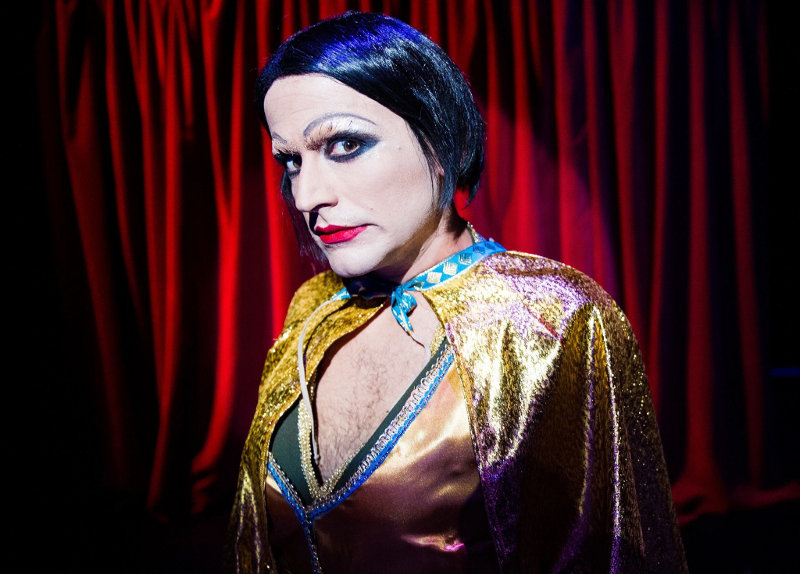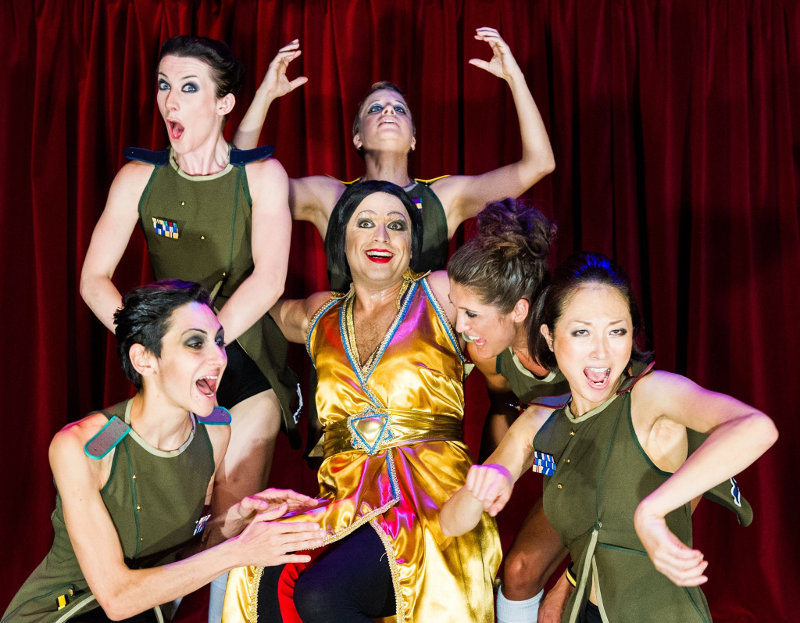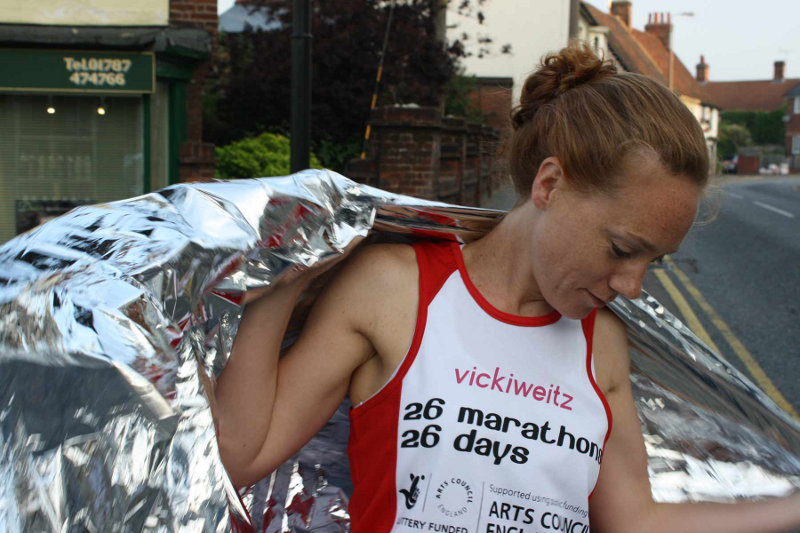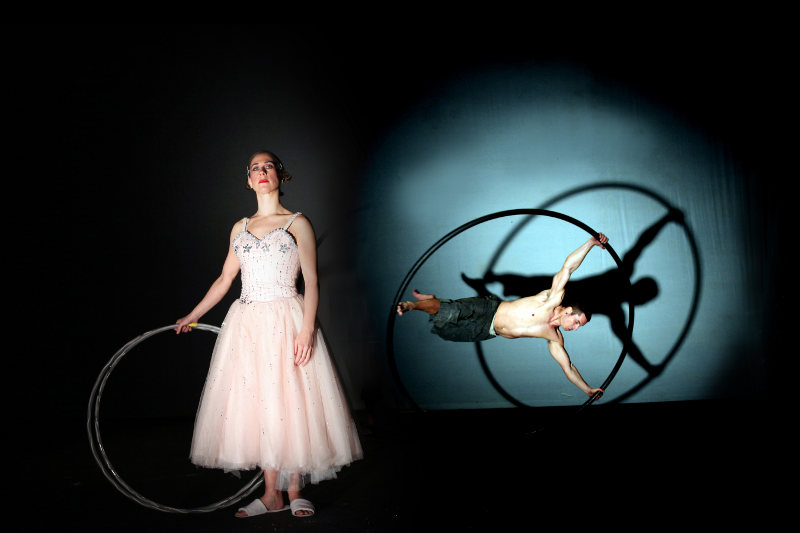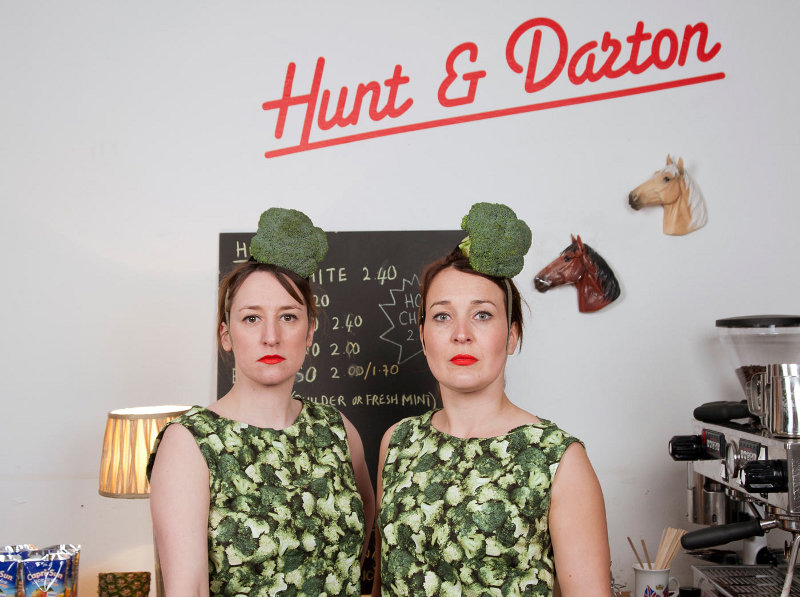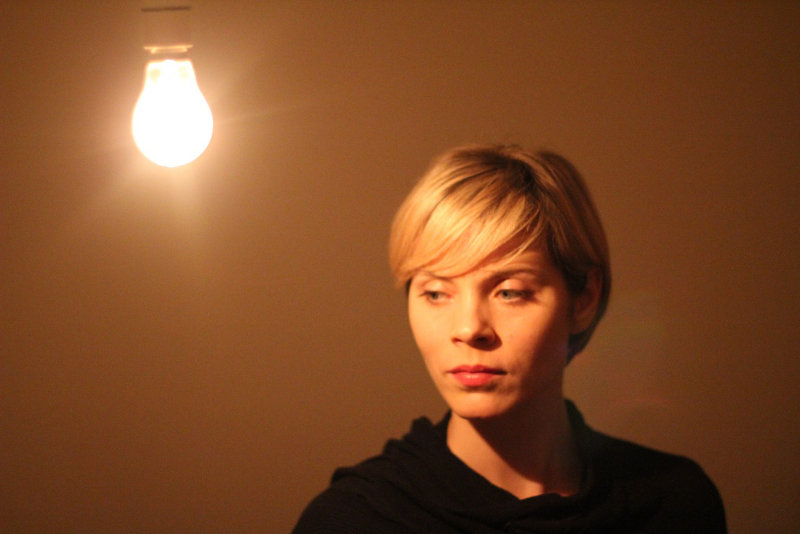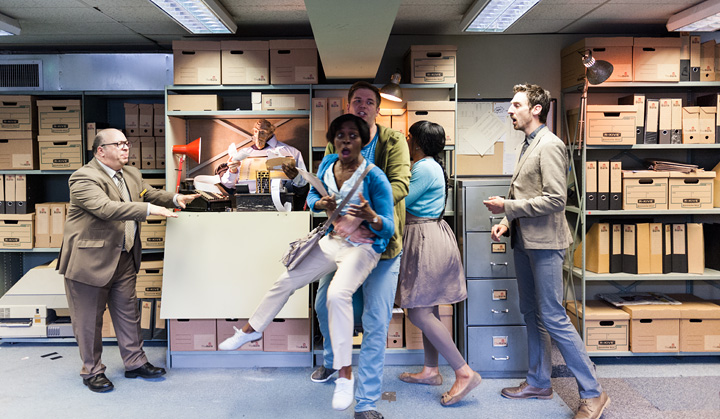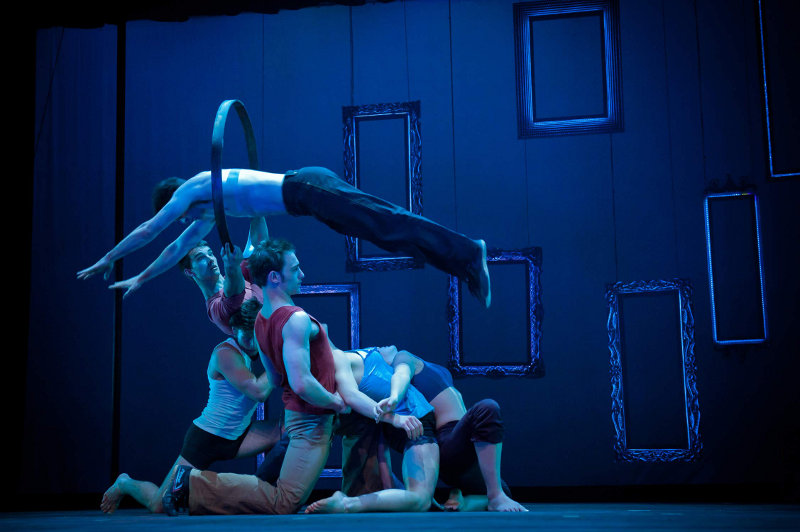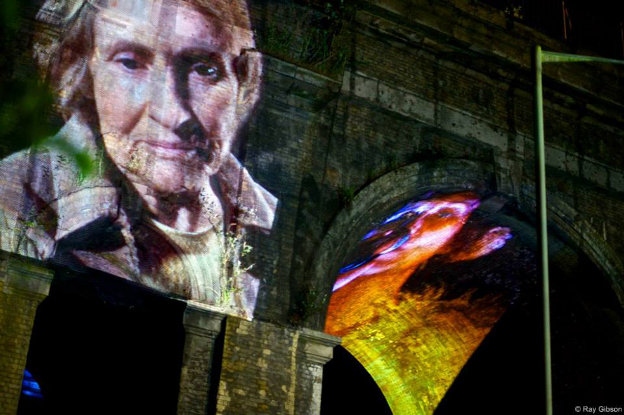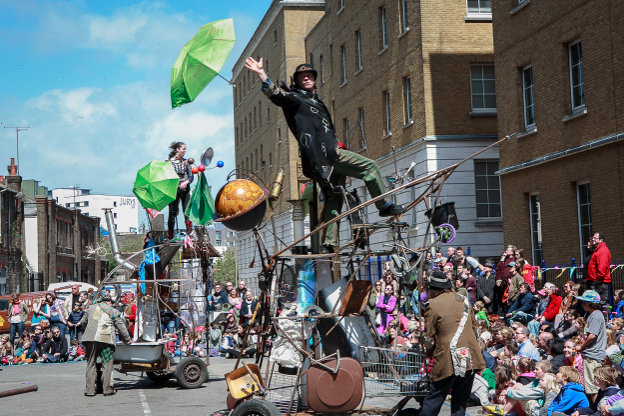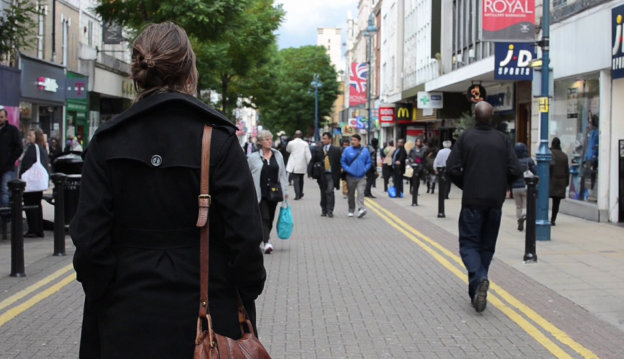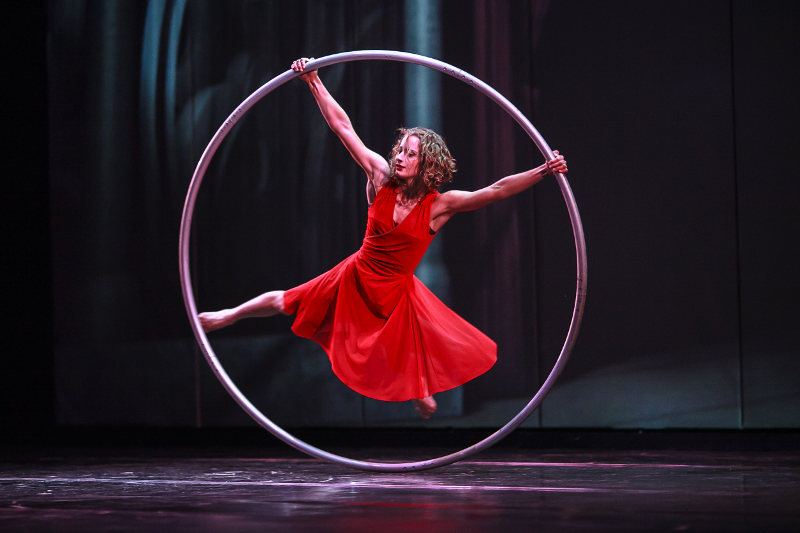
This May saw two major UK festivals – Brighton Festival and the Norfolk & Norwich Festival (NNF) – presenting a hefty amount of circus work from across the world. Unsurprisingly, Quebec and Australia were heavily represented…
The Quebec crew first: it’s hard for outsiders (and even insiders) to understand how a circus company could come all the way from Montreal to perform in England in May and not be booked by both Brighton and NNF – but what do I know? I realise that festival directors and their producers have all sorts of complex factors informing their decision-making. Be that as it may, Brighton opted for presenting Cirque Éloize’s Cirkopolis, whilst NNF went for the new Les 7 Doigts de la Main show, Séquence 8.
Cirque Éloize have always been one of my favourite circus companies, and Cirkopolis is a dazzling delight, although there are criticisms to be made. Inspired by Fritz Lang’s Metropolis and Terry Gilliam’s Brazil, it takes ideas and themes from these two films – mechanisation, consumerism, state control versus individual freedom, the rebel outsider, the role of fantasy in an over-ordered world – to create a series of thematically linked vignettes. A gorgeous design (by Robert Massicotte, who like many Éloize associates has previously worked for Cirque du Soleil) uses projection as a scenic backdrop: a wonderful Modernist cityscape cum factory is created, cleverly stealing visual motifs from both films – perhaps a little more weighted towards Metropolis’ towering skyscrapers, art-deco angles, Escher-like staircases, turning cogs, and giant ticking clocks.
There’s much to admire. One of the highlights of the show is a cyr wheel act by Angelica Bongiovanni who spins around the stage inside her wheel (a kind of overgrown hoop) with dizzying precision. She’s a vision of other-world loveliness, the machine-cog projections behind her shifting to a fantasy circus-sideshow painted-with-light backdrop of red and gilt drapes as she takes to the wheel. Another favourite scene is a witty and whimsical dance of unrequited love played out with a suit of clothes on a coat rail – gorgeous manipulation that takes us to a space between circus and object animation.
A criticism of Cirkopolis for some people is the rigid adherence to traditional male and female roles (this was a bit of a talking point in the bar after the show, the large number of UK circus performers and producers there forming an instant, informal post-show discussion group). This isn’t a big issue for me – most of the time, anyway. Although you could argue that it is a stereotypical image of woman as ‘other’, the gazed-upon object of desire, I find the scene in which a lone bare-footed woman deftly crosses a sea of male hands held high in the air breathtakingly beautiful and poignant (and the soft and sensuous acrobatic and contortionist skills of the female performer, Myriam Deraiche, are extraordinary). But oddly it is in the very scenes where usual gender roles are seemingly challenged that some unnecessary gender stereotyping crops up: for example, a two-person (one male, one female) upbeat Chinese Pole scene with a feisty unisex feel is suddenly cheapened by boy-meets-girl steal-a-kiss-and-get-your-face-slapped silliness.
There was a distinct lack of UK circus companies presented at these international festivals, for whatever reasons, but I was delighted to see that Cirkopolis’ international cast features two graduates of English circus schools, juggler-clown Ashley Carr (Circus Space) and Samuel Charlton (Circomedia), who gets in all over the place with hand-to-hand acro, banquine balancing, German wheel, Chinese Pole and (along with all the boys) teeterboard. This grand finale teeterboard act is impressive, but again there is a bit of a question about the traditional gender divide – beefy boys bouncing off the boards whilst these fabulously talented circus girls kind of decorate the scene, posing in retro swimwear. It’s lovely, but…
You’ve probably gathered that acrobatics, and equipment such as the various wheels, boards and balancing/juggling kit, are the mainstay of this particular Éloize show – there is little aerial work. This, though, seems to fit thematically with the wheels-of-industry man-machine theme very nicely. The show is presented for two evenings and a matinee at Brighton’s largest venue, the Dome, and on its last night receives a standing ovation from what looks to be a full house. There is most definitely a big audience for circus at the moment!
Meanwhile, over in Norwich, NNF have plumped for Les 7 Doigts de la Main’s Séquence 8, also from Montreal, also a UK premiere. Sometimes the hardest shows to write about are the ones you love best. With this one I just want to say ‘go and see it before you die’ and leave it that – but I realise that won’t do. Les 7 Doigts (the 7 fingers) are, as the name implies, a seven-strong company of circus artists trained to the highest level. Some of their shows feature members of that core company onstage (or dangling above it); sometimes they stay on the other side of the footlights. The latter is the case with Séquence 8, which sees two of the ‘7’, Shana Carroll and Sébastien Soldevila, sharing a director credit, and a fresh batch of precociously talented young performers set loose onstage, with the show devised around that particular team’s skills and strengths. And my goodness they are an energetic bunch: the cast of eight bounce off, around and through each other with astonishing skill, verve, humour and daredevil bravado. Sitting close to the front, I had my heart in my mouth many times over, marvelling at the sheer audacity of the sky-high lifts, death drops, and ridiculously fast throws and catches that come in relentless waves.
Well, almost relentless – the action is interspersed with an entertaining on-mic running commentary (by clown-narrator, acrobat, musician and all-round multi-tasker Colin Davis) that highlights and gently mocks the world of performance. Yes, it’s been done before – the mix of high-level skill and postmodern interrogation reminds me a little of the late great Nigel Charnock –but it’s done well, and is a clever way to build in breaks in the high-octane action. For example, around halfway through there’s a ‘non interval’, in which our narrator tells us that we can go for a pee or to buy a drink if we like, but in the meantime he’ll be hosting a quiz for those that stay, and ‘the winner gets to take home a performer of their choice’. ‘Question: is Max on the trapeze a) angry, b) hungry, c) not hungry, d) purple?’
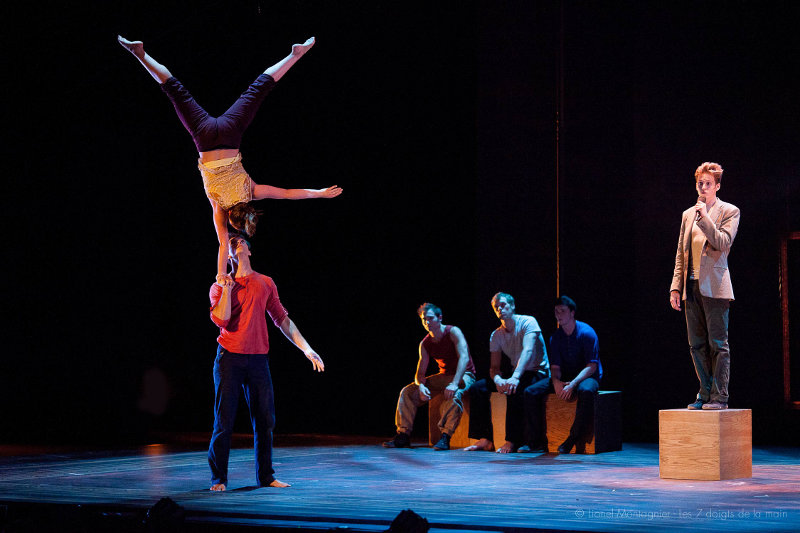
They are such a wonderful team and they have so much made this show their own that it is hard to single out individual acts – it’s all brilliant. But moments still with me are Eric Bates’ beat-boxing and blocks-juggling (to Tuung’s Bullets – some great soundtrack choices in this show); Ugo Dario’s gorgeously fluid dance to Julie London’s Cry Me a River, in which he weaves himself seductively through a maze of black sticky tape; a Russian barre act by the sinuous and cat-like Alexandra Royer; a teeterboard act that turns around a comic reflection on philosophical and artistic differences, set to the ghostly sounds of a ship creaking and lurching through the high seas; and the fabulous Chinese Pole work of Devin Henderson – not to mention the moment when he leaps offstage and snogs a man in the audience!
What’s it all about, then? Relationships, oppositions, contradictions, separation and togetherness – life, really. It’s about – everything! In many ways, it’s a show about circus itself – the highs and the lows, the breath and the blows – and thus of enormous appeal to anyone in the biz. But the riotous applause at the end of the show from this Norwich Theatre Royal festival audience proves that Séquence 8 isn’t just for the cognoscenti; it has massive popular appeal. I’d happily see it again and again: a glorious hybrid of astonishing circus, dance and physical theatre, all glued together with a healthy dose of knowing humour.
Over to the Aussies now: back in Brighton, also at a Theatre Royal (the lovely red plush Brighton Theatre Royal) comes Casus with Knee Deep. I’d previously seen this show when it made its debut at the Edinburgh Fringe 2012, presented at a Spiegeltent, and I wondered how it would work in an end-on regular theatre. The answer is very well – even better than at the Spiegeltent in fact, the proscenium arch setting and use of back projections framing the performers nicely. And the show has (inevitably I suppose) really benefited from its year of honing and touring since that auspicious Edinburgh debut last year (which got it shortlisted for a Total Theatre Award). It’s sleek and ultra-stylish, yet still really human, really present. The staging is simple: the minimal projections are actually live-feed video giving us close-ups of, for example, a row of eggs about to be walked upon. Most of the time though it’s down to the simple, elegant scenography of a classy lighting design (lots of subdued golds and browns and blues) to illustrate the bodies moving in space.
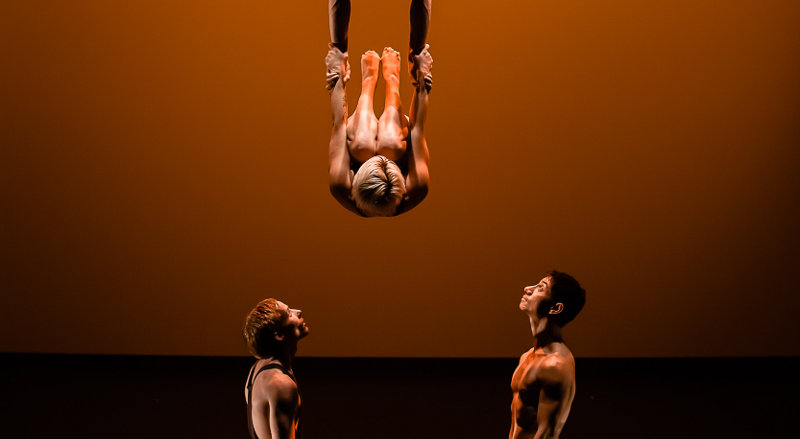
This is a young company, but made up of seasoned performers – three men and one woman. That woman is Emma Serjeant, and she is phenomenal. A NICA graduate and former full-time member of Australia’s leading contemporary circus company, Circa, she has it all – grace, strength, power, and delicacy; moving with ease from base to flyer. Not that the three boys lag behind in skill or stage presence – Jesse Scott, Lachlan McAulay and Natano Fa’anana are all a delight to watch, with Natano adding an extra layer of humour to the show with his knowing play on male eroticism (he’s also a member of the all-male circus-cabaret company Briefs). The show has no overarching narrative, but explores notions of strength and fragility, exposure and vulnerability (those eggs feature heavily, bottles and nails also making an appearance!). The core skills are acrobatics and balancing, with some aerial (rope, silks, straps) that is mostly classic moves performed absolutely beautifully, often with a challenge to gender expectations. The acrobalance, though, is astonishing. Sound and image work in wonderful harmony. The recorded soundtrack features found tracks, rather than commissioned compositions, but it’s a track listing showing excellent taste and an ear for the unusual: the quirky crackles of Múm vying with the whimsical strings and breathy vocals of Patty Plinko and Her Boy; the earthy and edgy growl of late-era Gil Scott-Heron contrasting with the gorgeous melancholy piano of Max Richter. It’s a show that has few aspirations towards circus-theatre but instead gets to the heart of circus: skill and beauty combined artfully to fantastic effect.
Meanwhile, in another part of Brighton (well, Hove actually – All Saints Church to be precise), Casus’ fellow Australian company Circa are presenting How Like an Angel. I don’t manage to see it here, but it turns out it is also at Norwich – and luckily I do get to see it there. Which feels perfectly right, as it was commissioned by NNF’s former director Jonathan Holloway – a truly creative producer who had the idea of placing Circa with Renaissance choral music company I Fagiolini, the only brief being that the repertoire be sacred music, and the performance respond to the sites it is presented in (cathedrals, large churches or other places of worship). This show in Norwich Cathedral feels something of a glorious homecoming. How Like an Angel explores the mythologies surrounding those heavenly creatures common to the three great monotheistic faiths of the world (Judaism, Islam and Christianity), messengers of God and guardians of the celestial spheres. It plays (physically and thematically) with the great magnetic pull between heaven and earth, the air and the ground: Lucifer’s expulsion from heaven, Adam and Eve’s fall from grace, Icarus’ doomed flight to heaven. Bodies drop from terrifying heights; voices soar into the highest reaches of the cathedral roof. The audience are free to move around the space, although it is not exactly a promenade piece – once we are in the main space most people stay put in their spot, turning heads from side to side or gazing up into the roof. The interaction between singers and circus performers is handled deftly by Circa’s director, Yaron Lischitz. The singers never look awkward or uncomfortable with their physical tasks – walking slowly through the crowd from different starting points, or (more ambitiously) being borne aloft by the circus performers.
But Angel isn’t Circa’s only show in this year’s Norfolk and Norwich Festival. I return the following week to see the same cast debuting Beyond, a brand new show made for Spiegeltents. Because of the vagaries of the M25 and A11, I arrive in Norwich halfway through the show, so cannot pass a full and fair judgement, but saw enough to perk my interest – and to see that there is an interesting dilemma here…
The setting and staging for Beyond is about as far from How Like an Angel as you could imagine. From the hushed cloisters of an echoing grey-stoned cathedral to a rammed red-plush-boothed Spiegeltent in full cabaret mode: no respectful silence here. From Tallis and St Hildegard to Andy Williams and Frank Sinatra in one quick move; simple and tasteful costumes in plain white silk and black cotton replaced by big white fake-fur bunny heads and Yogi bear suits. It’s a totally different aesthetic, but the shows seem like two sides of the same coin: if Angel is about the thin veil between human and angel realms, Beyond is about the fine line between human and animal – and the aspiration to escape the ground and rise above the bestial; to dream the Impossible Dream (‘to try when your arms are too weary, to reach the unreachable start… this is my quest.’).
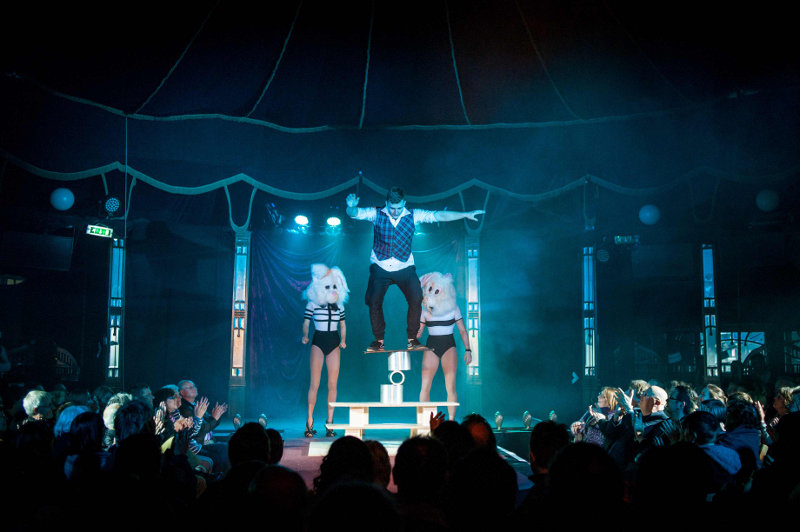
What’s odd though – in the section of the show that I saw anyway – is how much of the content from How Like an Angel is repeated in Beyond. Is it because this is inevitable with the same team performing two shows almost concurrently? After all, circus acts with this skill level take years to perfect. Are Circa banking on the fact that they won’t be getting the same audience for both shows, or that people won’t notice because the costumes and staging are so different? Or is it a deliberate artistic choice – to re-run ideas in a totally different setting to play on that contrast? Who knows! Despite the repetition of the core elements of some of the acts, I very much enjoy the Chinese Pole ascent in a furry bear suit, and the fantastic reversal of male-female base-flyer roles in the acrobalance (at one point, in both Angel and Beyond, one of the women bears three people simultaneously aloft on her head and shoulders). I’m less interested in the clear-glass bowls of water balanced on the bodies and carried around the space – it was an OK image in Angel (resonance of baptism, holy purification, etcetera) but really has no reason I can see to be in Beyond. But it is a new show, and I only caught the second half… I’ll live in hope of seeing it again somewhere soon. (It’s currently, June 2013, playing Wonderground on London’s South Bank.)
Also at the Adnams Spiegeltent in Norwich was the debut of a new cabaret show, Les Enfants Perdus, sadly unseen by Total Theatre as it clashed with Les 7 Doigts, but by all accounts an exciting new addition to the adult-only circus-cabaret circuit. We can also mention in passing that NNF very ambitiously programmed not only the circus shows reflected on here but also extended their reach to the Hippodrome in Great Yarmouth for Compagnie Galapiat’s Risque ZérO. It was a risk to programme so much circus, but a risk that seemed to pay off, going on the sold-out shows I saw in Norwich.
Back in Brighton, a different and very well established circus-cabaret evening runs the length of the Fringe festival at The Famous Spiegeltent’s little sister, Moulin Rouge – yes, it’s the return of the legendary La Clique. Well, I say ‘return’ but there has been much water under the bridge since La Clique first wowed Brighton and Edinburgh (and indeed the world) a decade ago. After many successful years, most of the mainstays of that show, including MC Brett Haylock, hostess with the mostest Miss Behave, the always impressive Ursula Martinez, Franco-Irish chanteuse Camille O’Sullivan, and the various bendy boys and boys in bath tubs that shared the bill with them, left to form rival Spiegeltent cabaret show La Soiree, or to pursue other projects. A crude analysis of the situation from an outsider’s perspective is that Brett Haylock kept the stars and Spiegelmaestro David Bates kept the name, relaunching the brand with new artists.
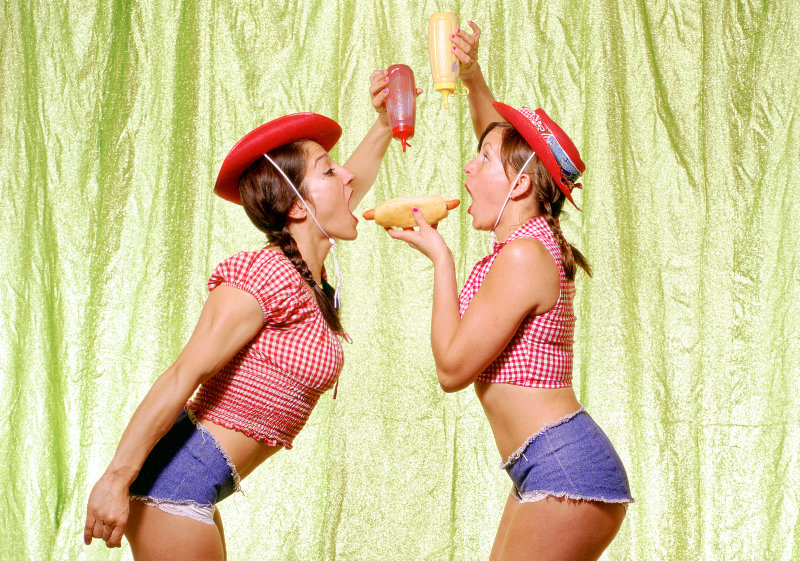
So – how is the new La Clique? Not bad is the short answer – not as strong as those early legendary line-ups, but a pretty good evening’s entertainment, with quality circus acts still integral to the show. La Clique always had a raunchy vibe – more circus sideshow than regular variety show – but the new version has tipped over into hardcore burlesque, with verbal sexual innuendo and visual double-entendre ever-present. Take, for example, Scotty the Blue Bunny, whose act is very much what it says on the can: a big man dressed in a skin-tight blue lycra bunny suit, ears and all, who camps about and cracks jokes and does silly things with balloons. There’s an MC who does that excruciating rubber-band wrapping thing on his face, and a striptease act with a surprise ending from someone who would probably like to be the new Ursula Martinez but falls a bit short, although s/he has a demented energy that I enjoy. Magician-comedian Paul Zenon is entertaining, despite doing the same tricks and jokes as seen at La Clique in 2005; and Movin’ Melvin is his usual cheery and lovely self, tapping his way through Ray Charles classics. There’s a good hula hoop act from someone who is not Marawa the Amazing – perhaps she was having a night off – but a good substitution, a feisty girl with great stage presence, and, as her additional tea-cup and spoon act showed, something of the Miss Behave about her.
Sadly the magnificent Mikelangelo was also off duty that night (although I did luckily catch him and his Black Sea Gentlemen in their own shimmering music-cabaret show earlier that week), so that particular evening felt the lack of a quality crooner. The scene-stealer of this line-up was male aerialist Stephen Williams, who opened with a piano-top whiskey-soaked dance, returning later for an aerial straps act in the role of a car mechanic (tyres providing a useful double purpose of set and safety device). There is, inevitably, a trouser-removing moment. Away with you bath tub boys – it’s all about axle grease these days. A nod also to the very talented Wau Wau sisters, a burlesque-circus duet who combine doubles trapeze with audience participation acro in Dolly Parton drag.
From Spiegeltent to circus tent: the darlings of UK circus NoFit State were back in Brighton for the festival month, although this year not programmed into the main festival, as they have been previously, but instead part of the Fringe. It is odd that a show like Bianco by a world-class company like NoFit State was not presented in the main programme, but I am sure there are reasons.
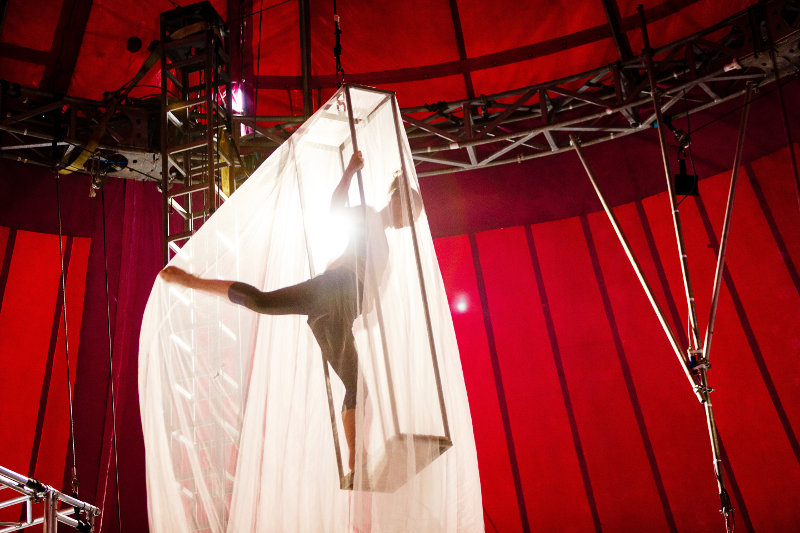
Bianco (subtitled Turning Savage) is, on paper, ‘the story of a great journey inside and outside ourselves… a battle between beauty and brutality’. What we get are all the things we love about NoFit State: a big bouncy cast of acrobats tumbling all over the place; the thrill of being herded round the tent as aerialists swing and swoop above; a rip-roaring and raunchy live band; and the smell of popcorn always nearby. This may be contemporary circus, but it’s also good old-fashioned circus through and through. The company could be the inspiration for the phrase ‘motley crew’: tattooed riggers, gold-toothed ushers, tousle-haired trapezists, bristle-chinned fire-eaters. The downside is the set – a number of no-doubt expensive but cumbersome white scaffolding structures that get hauled around the space, making audience movement less fluid than is usual in NoFit State shows (the performer-stewards often having to explain very precisely where we need to stand to avoid being crushed, rather than the usual organic process of gentle herding we get in other shows). The structures look impressive and are swung and bounced from merrily, but these ensemble routines, although good, aren’t spectacular enough to justify all the trouble moving these things around. That aside, there are (as always) many top quality acts to marvel at: I love Anne-Fay Johnston’s giggly mock-wobbly handstands, and Elena Burani’s elegant rope work. The company’s current roster includes a number of top-notch British aerialists, including Circus Space trained August Dakteris with a big and beefy straps routine, doubles trapeze (well, it was actually an odd kind of moving frame rather than a trapeze, reminiscent of something Ockham’s Razor might use) from Lyndall Merry and Freya Watson, both Circomedia grads. There’s also an ensemble of less experienced aerialists that provide a chorus-line of rope, in line with NoFit State’s policy of integrating performers at different levels of experience into their shows. The design is lovely, with many beautiful images still glowing in my mind long after the lights go down. Lots of white (of course), including a spectacular ceiling-to-floor wedding dress shedding red rose petals, and a chorus of silver-and-white twirling canopied swings descending to the ground.
NoFit State’s writer/director Firenza Guidi seems to have accepted with this production that it is hard to push through a strong linear narrative in a circus performance, which by its very nature is episodic, and has instead gone for thematic links over ‘story’: Bianco feels less of an attempt at a circus-theatre amalgam than either Immortal or Tabu. Which is not a criticism – ultimately, it’s raunchy and robust circus full of thrills and spills, and that’s good enough for me.
NoFit State’s Bianco troupe is a truly international ensemble, featuring artists from Wales, England, Ireland, America, Quebec, Italy, and Portugal. That’s the nature of circus – it embraces the world. It was fantastic to see so many world-class circus shows putting the spring into May’s step in Norwich and Brighton – and great to see so many UK circus artists making their mark on the world stage (or tent).
Dorothy Max Prior saw Cirque Éloize, Cirkopolis at the Dome Brighton, 7 May 2013; Casus Knee Deep at Theatre Royal Brighton 14 May 2013; Les 7 Doigts de la Main, Séquence 8 at Theatre Royal Norwich 17 May 2013; Circa, How Like an Angel at Norwich Cathedral 17 May 2013; No Fit State Circus, Bianco at No Fit State’s spaceship tent, Hove Lawns 27 May 2013; La Clique at The Famous Spiegelgarden, Brighton 29 May 2013.

